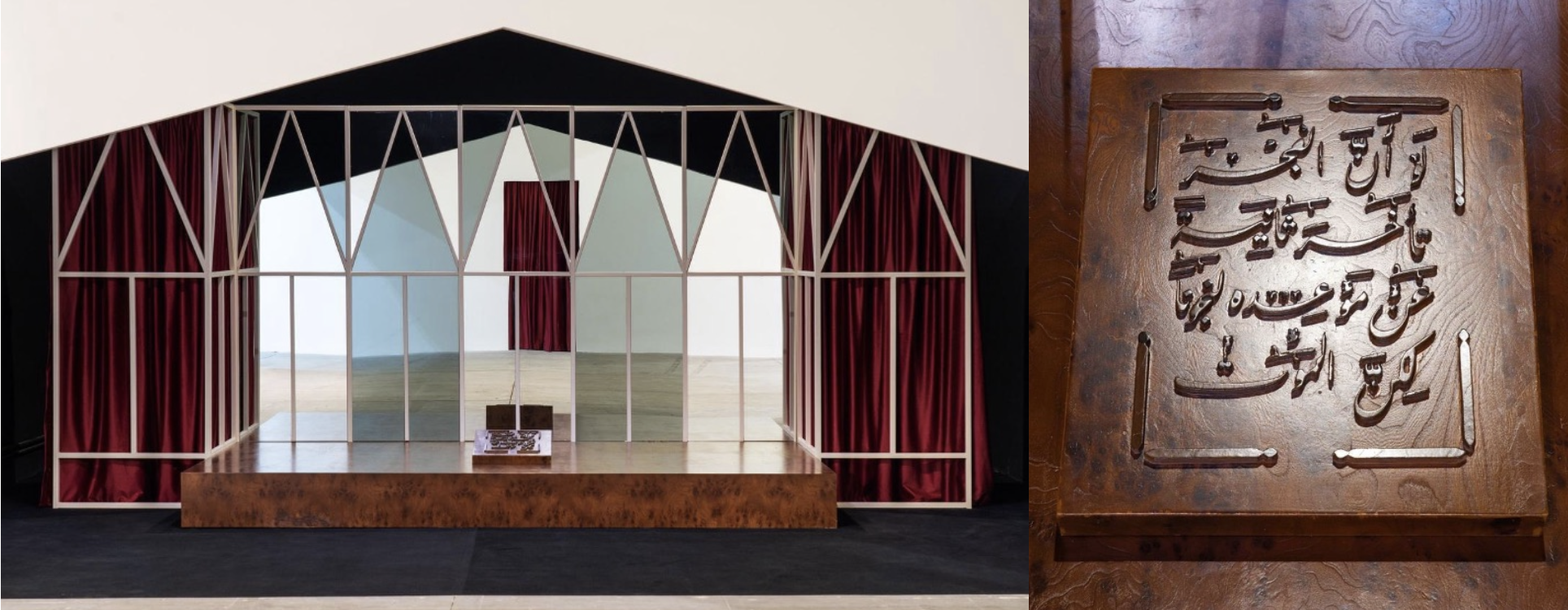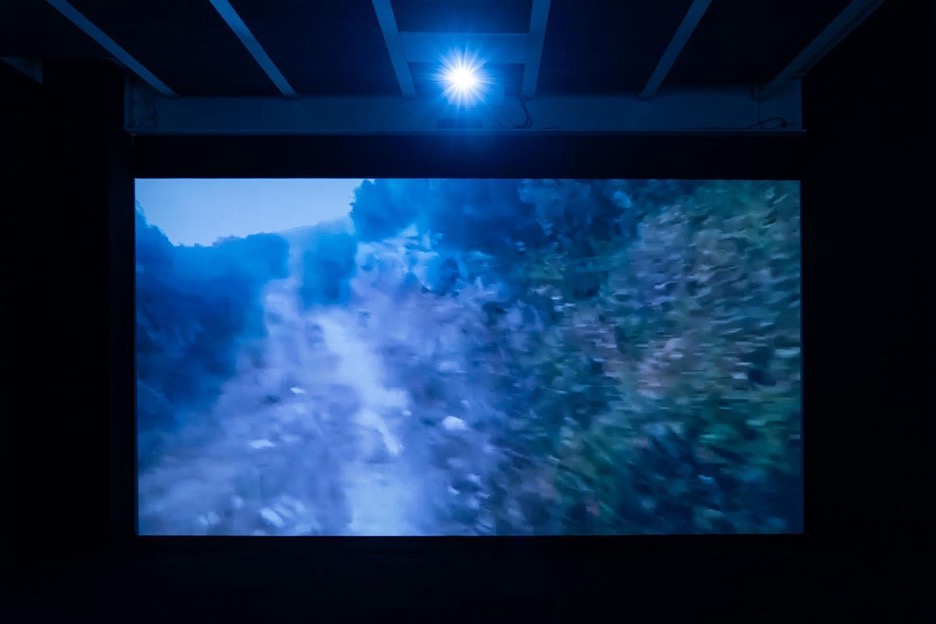Hussein Nassereddine’s first major exhibition in Beirut is beautiful and bewildering. Beautiful in its deft handling of various media, in the layers of soundscapes, in its open-ended theatrical stages, and abrupt shifts in scenography. And bewildering due to the pressing sense that the various scenes that compose the exhibition are always preceded and loaded with text. For inasmuch as the exhibition conversantly deploys the visualities of theatrical presence and object-specific presentness, the exhibition is firstly set and upset by text, and more precisely by aphorisms, verses of Jahili poetry, parts of Qurʾanic ayāt, and fragments from modern poetry. And what congregates these written signs is a deep concern with and an untranquil contemplation of time.

It may seem upon first viewing that Nassereddine’s work evolves within a long tradition, found in many artistic genealogies, of the memento mori and the defeat of the contemplator before the inexorable ruinating work of time. But there is more to this exhibition than just the ruin, its precession and death as the ultimate equalizer. There is an earnest summoning of an eruption from within time, a yearning for an exit, a liberation, or perhaps a slippage out of the fetters of time. This constitutes a theme that runs throughout the exhibition. Note for instance the visually stunning piece made of four engraved zinc plates titled The Image of Water (Fig.2) which attempts to cast a fixed form to flux, or the series of stamped leather book covers titled Even the Most Delicate of Hands Could Not Hold the River (Fig. 1) spread eagle against colored walls, holding nothing but the alleged legendary voices of chanters, singers and poets. Also, the piece titled A Few Decent Ways to Drown (Fig. 3), which offers a light-sensitive paper to capture all the unrecallable in poetry.


True, these works speak of the affect of loss and remind us of death. But they also push against the grain of the memento mori even as they seem to employ its tropes. For in their attempt to fix and hold, to recall and recapture, they do not offer a docile or wistful illustration of the passage of time and its consuming traces. Rather, these works attempt the impossible and that is to capture time. The Image of Water is not a representation of the flow of time, nor is the blue carbon paper that makes up the surface of the pond in A Few Decent Ways to Drown an illustration of a fleeting watery surface. Rather, in both cases, there is an attempt to outdo time and grab it, to outsmart and snare it. Accordingly, these works are indexical rather than iconic signs. They point like smoke to fire or a weathervane to wind. They are motivated signs, possible only because they chase time, and so are unlike representation. But this, it must be said, is not a consequence of the visual forms alone, at least not fully. Rather, it is also prompted by the quizzical and ambivalent co-presence of strongly evocative and contentious textual signs that frame the exhibition and are disseminated on copious labels and the large, elegantly designed wall text that welcomes visitors. One such sign is the end part of the Qurʾanic verse 47 from Surat Al-Hajj: “But a day of God’s days is indeed like a thousand years by your counting.”1 Another is a verse from Amr Ibn Kulthum’s (526–584 CE) most famous suspended ode that belongs to a pre-Islamic conception of time as duration, or dahr, which erases human works without hope for life beyond death: “And of a surety the fates will overtake us predestined for us, as we for them are predestined.”2 The co-presence of verse 47 from Surat Al-Hajj and the fatalism of Ibn Kulthum’s poetry exacerbates the temporal instability upon which the exhibition seems to float. For as the scholar of Islam, Gerhard Böwering writes, dahr “is the cause of earthly happiness and misery; it is death’s doom and the measure of destiny; it changes everything and nothing resists it.”3 Accordingly, Islam rejects it as fatalism and Islamic heresiographers condemn those who divinize Duration (dahr) as materialists or Dahriyūn. Bowering writes further that “there is no place in the Qurʾan for impersonal time; each person’s destiny is in the hands of the God…Allah is the Lord of each instant.”4 Therefore, time in Islam is not a continuous duration but, as Louis Massignon explains, “a constellation, a galaxy of instants […].”5 The co-presence of pre-Islamic conception of time as dahr and the Qurʾanic verse which reminds of God’s dominion over the atomization of time into instants or ān (pl. anāt) generates a tension with which each visual set-up in Nassereddine’s exhibition reverberates: Time as duration wherein “everything is written” as George Wassouf sings, “one day you are defeated, one day you will prevail”6 and time as instants governed by Allah, in each of which He creates and recreates the universe and all that is in it. One is an unstoppable river that overflows, and the other is the pulse of the Creator, the breathing of Allah that makes and unmakes. One is impersonal, the other is specific to each of God’s servants.

Fig. 4b, detail.
It is precisely before this binary, that one begins to recognize that the underlying problematic of Nassereddine’s work is one of a search for an instant, or to be more precise, but also more speculative, for an in-between-two-instants, when and where an exit might be found. This the artist intimates most convincingly in the scenography and wall texts of the two adjacent theatrical installations titled Years of the Shining Face: You were right, O Heart (Fig. 4) and Years of the Shining Face: The Palm Tree Forest (Fig. 5) and the two-channel video installation titled Years of the Shining Face: She Walked On By (Fig. 6). In the first, the artist constructs what looks like the headstone of a grave and on it embosses a verse from the poem “A lullaby for Zainab” by Muhammad Ali Chamseddine: “Had the dawn, been delayed for only a second, we would have survived, but death."8 (Fig. 4b) This verse takes center stage in the first of these two installations and is placed on a raised Formica dais, surrounded by mirrored panels and crimson curtains. In the second installation, the artist builds an open-form and unroofed hypostyle, equivocally appearing like a garden of palm trees. This stage set, with its burning red background, is accompanied by a label of printed musings on time. We read about the travels of palm trees and migrations overland of the emir of Cordoba, Abdel Rahman the Entrant (731-788 CE). We learn that the emir, once in Andalusia, never saw a palm tree for thirty years until he miraculously saw one in the Rusafa of Cordoba, “minded the time, and died in an instant under the shade of his palm tree.”

The third installation is composed of two video footages and spoken words recorded by the artist’s mother, Noura, and recounts a revelatory experience when she saw in the distance a man on a horse with a face “shining in the field like a planet” relaying a greeting from her son Mahdi and enjoining her, in true Qur ʾ anic faith, not to be sad. The video performs nothing of the above-mentioned, rather it looks at the bush and scrub, at a footpath and up towards the sky. It neither delivers the miracle nor denies it. It simply looks for it while the voices tell of the visibly unavailable. A search for the renegade instant, for the eruption of the event from within time; before the second, just after the instant, through the blinding shine, underlies the three installations and the variety of stage settings.

Is the exhibition Years of the Shining Face the work of an apostate, a revolutionary, a prophecy seeker, or a pious orthodox? Is it an invitation to muse over lost times and long for their return, or is it a call to be patient and await the call of the caller? Or is it rather a bid to exit into the non-time of ecstasy? Nassereddine’s art is at its beginning, and the succeeding chapters of his journey will have much to tell. But for now, as we walk the halls of his current exhibition, smitten and bewildered, it seems plausible to say that his art is one that knows well how to use image and text, and yet it is an art that is moving away gingerly towards light and sound. It is also an art that understands the thrills of spectating and the immersivity of reading, but chooses instead the blinding light and the humbleness of hearing. And what it has for a guide, in its long journey, is the voice of the singer. Absent yet intimated throughout the exhibition, it is the singer’s voice that gathers the many contentious temporal strands of the exhibition. For it is the singer who also can bend time, can halt it and enthrallingly slip between its instants in an experience which “Arabs have named tarab and in their language have defined as a levity which seizes in happiness or in sadness.”9 Tarab, the furtive guiding concept of the exhibition, and a term jealously kept absent from the plenteous lexicon of the exhibition.
Exhibition Details
Hussein Nassereddine - Years of the Shining Face
6 February – 6 June 2025, Beirut Art Center.